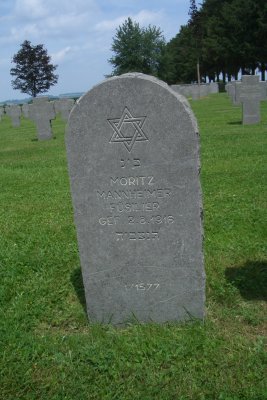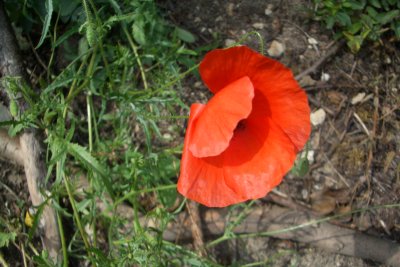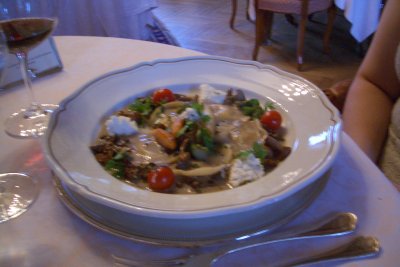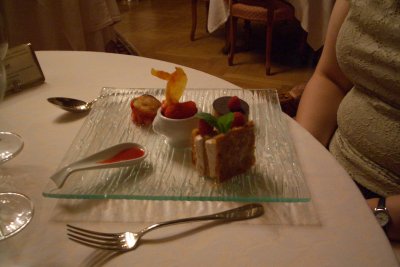Wednesday, 13 June 2007, Le Chemin des Dames
Written 13 June 2007
Beakfast at Au Fou du Roy: chunks of baguette, petits pains au lait, excellent hot croissants, café au lait (with cold milk) and tea, fresh OJ, yogurt, ham, bologna, cheese slices, butter, three jams, honey.
We set off about 11 a.m. (because CJ went up to brush her teeth after breakfast, sat down, and fell asleep again) for the western end of le Chemin des Dames (the Ladies' Road), a famous road that runs along the top of a long ridge, with steep drop-offs on both sides and extensive tufa quarries tunnelling underneath. It got its name from a period during which the grown sisters of Louis XV, called "Mesdames" ("Miladies"), travelled it periodically to visit their governess in her retirement. To make the trip easier, the king had the road improved and gravelled. The unusually long and steep ridge it runs along is a formidable natural barrier to the movements of troops, so the road along its top marks a high spot that both armies were anxious to occupy, since whatever side holds the ridge can repel the advances of the other. It was taken and retaken four or five times during the war, sometimes at long intervals and sometimes at short, but always bloodily. It was the site of General Nivelle's great fiasco, after which we was replaced with Pétain (hero of WWI, goat of WWII). In the process, the local area got beaten to a pulp. It was estimated that, on average, an explosive shell landed on every square meter, each of which blew a 10-m crater. Not a tree or even a blade of grass survived. Many villages were simply obliterated and were rebuilt elsewhere or not at all.


 We stopped at each featured location along it, and sometimes just to admire the magnificent views of the countryside on both sides, though we didn't have time or inclination to do all the walking trails. David was disappointed that the Fort de Malmaison is now closed to unescorted visitors, but we visited the German cemetery there (actually from WWII, unlike the others in the area), filled with row on row of black iron crosses. The French cemetery at Crécy had a beautiful memorial chapel and stone crosses, interspersed with quite a number of round-topped markers with muslim symbols for members of the colonial regiments. The adjacent WWI German cemetery had wider, stockier granite crosses, interspersed, unlike the WWII ones, with occasional stars of David.
We stopped at each featured location along it, and sometimes just to admire the magnificent views of the countryside on both sides, though we didn't have time or inclination to do all the walking trails. David was disappointed that the Fort de Malmaison is now closed to unescorted visitors, but we visited the German cemetery there (actually from WWII, unlike the others in the area), filled with row on row of black iron crosses. The French cemetery at Crécy had a beautiful memorial chapel and stone crosses, interspersed with quite a number of round-topped markers with muslim symbols for members of the colonial regiments. The adjacent WWI German cemetery had wider, stockier granite crosses, interspersed, unlike the WWII ones, with occasional stars of David.
 Our longest stop was at Museum of the Caverne du Dragon (Drachenhöle, Dragon's Cave), a huge tufa quarry consisting of a network of large tunnels and chambers with a total area of about 5 acres. Needless to say, possession of it was highly desirable, so it too changed hands several times. At one point the Germans held the northern half, the French lived in the southern quarter, and the remainder was a sort of no-man's-land between the walls the two sides built to exclude each other.
Our longest stop was at Museum of the Caverne du Dragon (Drachenhöle, Dragon's Cave), a huge tufa quarry consisting of a network of large tunnels and chambers with a total area of about 5 acres. Needless to say, possession of it was highly desirable, so it too changed hands several times. At one point the Germans held the northern half, the French lived in the southern quarter, and the remainder was a sort of no-man's-land between the walls the two sides built to exclude each other.
 We had lunch there before going on the 3 p.m. guided tour. Lunch consisted of popsicles, because not so much as a sandwich or a sausage was to be had for miles around, and the museum's snack bar had only coffee, soft drinks, wine, and popsicles. When the time came for our tour, they were able to lend us jackets; we hadn't thought to bring any, and it's 12 degrees C in the cavern. The tour takes 90 minutes (including a 20-minute movie) and includes areas used as barracks, an infirmary, storage, communications, etc., as well as works of memorial art and examples of the kinds of souvenirs that the troops made from the brass of spent shells. It would have been damp, cold, dark, crowded, and smelly, and some heavier-than-air poison gas was usually sloshing around near the floor, having seeped in from the battlefield, but it was apparently much better than the hellish conditions above ground.
We had lunch there before going on the 3 p.m. guided tour. Lunch consisted of popsicles, because not so much as a sandwich or a sausage was to be had for miles around, and the museum's snack bar had only coffee, soft drinks, wine, and popsicles. When the time came for our tour, they were able to lend us jackets; we hadn't thought to bring any, and it's 12 degrees C in the cavern. The tour takes 90 minutes (including a 20-minute movie) and includes areas used as barracks, an infirmary, storage, communications, etc., as well as works of memorial art and examples of the kinds of souvenirs that the troops made from the brass of spent shells. It would have been damp, cold, dark, crowded, and smelly, and some heavier-than-air poison gas was usually sloshing around near the floor, having seeped in from the battlefield, but it was apparently much better than the hellish conditions above ground.
 We drove back to Fère by a different route, paralleling the River Aisne part of the way. The fields are planted with a little corn, some broad beans, occasional fields of flax (some of it bloom), lots and lots of sugar beets, oilseed rape, and grain (mostly wheat and something with erect awnless ears and bluish stems; barley? rye? not oats, I think). Many of the fields are bordered by bright red poppies in bloom. I saw one field of sunflowers, still far too young to be in bloom.
We drove back to Fère by a different route, paralleling the River Aisne part of the way. The fields are planted with a little corn, some broad beans, occasional fields of flax (some of it bloom), lots and lots of sugar beets, oilseed rape, and grain (mostly wheat and something with erect awnless ears and bluish stems; barley? rye? not oats, I think). Many of the fields are bordered by bright red poppies in bloom. I saw one field of sunflowers, still far too young to be in bloom.
For our second dinner at the Château, we David and I chose the lesser "market" menu. CJ ordered à la carte, to avoid the fish and nuts problem.
With the apperitif, the same gougères and pistachio cake, but the pizzas had been replaced by tiny croissants with anchovies in them.
Amuse bouche: a quenelle each of pink shrimp mousseline and "eggplant caviare," both excellent, another sesame crisp, and a strip of marinated raw fish (omitted from CJ's portion).
 First course: CJ got the spring vegetable raviolis with ricotta and mousseron mushroom emulsion that she had wanted the night before but had been unavailable (and is now her candidate for best dish of the trip). David and I had the foie gras again, in a slightly larger portion because of the smaller number of courses.
First course: CJ got the spring vegetable raviolis with ricotta and mousseron mushroom emulsion that she had wanted the night before but had been unavailable (and is now her candidate for best dish of the trip). David and I had the foie gras again, in a slightly larger portion because of the smaller number of courses.
Second course: CJ got filet of beef with confit shallots and more mushrooms. We had pan-roasted "quasi" of veal (I'll have to look up what cut that is; it could have been filet) with green and white asparagus, mushrooms, and more of those lovely confit cherry tomatoes.
Cheese: CJ has become a fan of camembert and reblochon, so she stuck with those. David had roquefort, boulette d'Avesne, and maroilles. I had more of their excellent Puligny St. Pierre, part of a crottin de Chavignol that was making a break for the edge of the platter (yum!), and boulette d'Avesne.
 Dessert: David and I had a warm "moelleux" of chocolate (a freshly baked moist and creamy cake (like an intense but fragile brownie that's died and gone to heaven). CJ had theme and variations on the strawberry, which included the fresh berries, with a slightly sweetened sauce, a sour variation on the sauce for dipping, strawberry mousse sandwiched with sheets of crisp pastry, a small strawberry cake, and, sandwiched between two disks of chocolate, a ball of balsamic vinegar sorbet! (Interestingly, when CJ tried to pick up the porcelain spoon full sour sauce, she found it was glued to the plate with thick sugar syrup, as was the dish of strawberries—a good way to ensure that they stayed in place as the waiters carried three or four plates at a time.)
Dessert: David and I had a warm "moelleux" of chocolate (a freshly baked moist and creamy cake (like an intense but fragile brownie that's died and gone to heaven). CJ had theme and variations on the strawberry, which included the fresh berries, with a slightly sweetened sauce, a sour variation on the sauce for dipping, strawberry mousse sandwiched with sheets of crisp pastry, a small strawberry cake, and, sandwiched between two disks of chocolate, a ball of balsamic vinegar sorbet! (Interestingly, when CJ tried to pick up the porcelain spoon full sour sauce, she found it was glued to the plate with thick sugar syrup, as was the dish of strawberries—a good way to ensure that they stayed in place as the waiters carried three or four plates at a time.)
Mignardises: The same as the night before, but with chocolate swirl cookies substituted for the red fruit paste.
previous entry
List of Entries
next entry


 We stopped at each featured location along it, and sometimes just to admire the magnificent views of the countryside on both sides, though we didn't have time or inclination to do all the walking trails. David was disappointed that the Fort de Malmaison is now closed to unescorted visitors, but we visited the German cemetery there (actually from WWII, unlike the others in the area), filled with row on row of black iron crosses. The French cemetery at Crécy had a beautiful memorial chapel and stone crosses, interspersed with quite a number of round-topped markers with muslim symbols for members of the colonial regiments. The adjacent WWI German cemetery had wider, stockier granite crosses, interspersed, unlike the WWII ones, with occasional stars of David.
We stopped at each featured location along it, and sometimes just to admire the magnificent views of the countryside on both sides, though we didn't have time or inclination to do all the walking trails. David was disappointed that the Fort de Malmaison is now closed to unescorted visitors, but we visited the German cemetery there (actually from WWII, unlike the others in the area), filled with row on row of black iron crosses. The French cemetery at Crécy had a beautiful memorial chapel and stone crosses, interspersed with quite a number of round-topped markers with muslim symbols for members of the colonial regiments. The adjacent WWI German cemetery had wider, stockier granite crosses, interspersed, unlike the WWII ones, with occasional stars of David. Our longest stop was at Museum of the Caverne du Dragon (Drachenhöle, Dragon's Cave), a huge tufa quarry consisting of a network of large tunnels and chambers with a total area of about 5 acres. Needless to say, possession of it was highly desirable, so it too changed hands several times. At one point the Germans held the northern half, the French lived in the southern quarter, and the remainder was a sort of no-man's-land between the walls the two sides built to exclude each other.
Our longest stop was at Museum of the Caverne du Dragon (Drachenhöle, Dragon's Cave), a huge tufa quarry consisting of a network of large tunnels and chambers with a total area of about 5 acres. Needless to say, possession of it was highly desirable, so it too changed hands several times. At one point the Germans held the northern half, the French lived in the southern quarter, and the remainder was a sort of no-man's-land between the walls the two sides built to exclude each other. We had lunch there before going on the 3 p.m. guided tour. Lunch consisted of popsicles, because not so much as a sandwich or a sausage was to be had for miles around, and the museum's snack bar had only coffee, soft drinks, wine, and popsicles. When the time came for our tour, they were able to lend us jackets; we hadn't thought to bring any, and it's 12 degrees C in the cavern. The tour takes 90 minutes (including a 20-minute movie) and includes areas used as barracks, an infirmary, storage, communications, etc., as well as works of memorial art and examples of the kinds of souvenirs that the troops made from the brass of spent shells. It would have been damp, cold, dark, crowded, and smelly, and some heavier-than-air poison gas was usually sloshing around near the floor, having seeped in from the battlefield, but it was apparently much better than the hellish conditions above ground.
We had lunch there before going on the 3 p.m. guided tour. Lunch consisted of popsicles, because not so much as a sandwich or a sausage was to be had for miles around, and the museum's snack bar had only coffee, soft drinks, wine, and popsicles. When the time came for our tour, they were able to lend us jackets; we hadn't thought to bring any, and it's 12 degrees C in the cavern. The tour takes 90 minutes (including a 20-minute movie) and includes areas used as barracks, an infirmary, storage, communications, etc., as well as works of memorial art and examples of the kinds of souvenirs that the troops made from the brass of spent shells. It would have been damp, cold, dark, crowded, and smelly, and some heavier-than-air poison gas was usually sloshing around near the floor, having seeped in from the battlefield, but it was apparently much better than the hellish conditions above ground. We drove back to Fère by a different route, paralleling the River Aisne part of the way. The fields are planted with a little corn, some broad beans, occasional fields of flax (some of it bloom), lots and lots of sugar beets, oilseed rape, and grain (mostly wheat and something with erect awnless ears and bluish stems; barley? rye? not oats, I think). Many of the fields are bordered by bright red poppies in bloom. I saw one field of sunflowers, still far too young to be in bloom.
We drove back to Fère by a different route, paralleling the River Aisne part of the way. The fields are planted with a little corn, some broad beans, occasional fields of flax (some of it bloom), lots and lots of sugar beets, oilseed rape, and grain (mostly wheat and something with erect awnless ears and bluish stems; barley? rye? not oats, I think). Many of the fields are bordered by bright red poppies in bloom. I saw one field of sunflowers, still far too young to be in bloom. First course: CJ got the spring vegetable raviolis with ricotta and mousseron mushroom emulsion that she had wanted the night before but had been unavailable (and is now her candidate for best dish of the trip). David and I had the foie gras again, in a slightly larger portion because of the smaller number of courses.
First course: CJ got the spring vegetable raviolis with ricotta and mousseron mushroom emulsion that she had wanted the night before but had been unavailable (and is now her candidate for best dish of the trip). David and I had the foie gras again, in a slightly larger portion because of the smaller number of courses. Dessert: David and I had a warm "moelleux" of chocolate (a freshly baked moist and creamy cake (like an intense but fragile brownie that's died and gone to heaven). CJ had theme and variations on the strawberry, which included the fresh berries, with a slightly sweetened sauce, a sour variation on the sauce for dipping, strawberry mousse sandwiched with sheets of crisp pastry, a small strawberry cake, and, sandwiched between two disks of chocolate, a ball of balsamic vinegar sorbet! (Interestingly, when CJ tried to pick up the porcelain spoon full sour sauce, she found it was glued to the plate with thick sugar syrup, as was the dish of strawberries—a good way to ensure that they stayed in place as the waiters carried three or four plates at a time.)
Dessert: David and I had a warm "moelleux" of chocolate (a freshly baked moist and creamy cake (like an intense but fragile brownie that's died and gone to heaven). CJ had theme and variations on the strawberry, which included the fresh berries, with a slightly sweetened sauce, a sour variation on the sauce for dipping, strawberry mousse sandwiched with sheets of crisp pastry, a small strawberry cake, and, sandwiched between two disks of chocolate, a ball of balsamic vinegar sorbet! (Interestingly, when CJ tried to pick up the porcelain spoon full sour sauce, she found it was glued to the plate with thick sugar syrup, as was the dish of strawberries—a good way to ensure that they stayed in place as the waiters carried three or four plates at a time.)